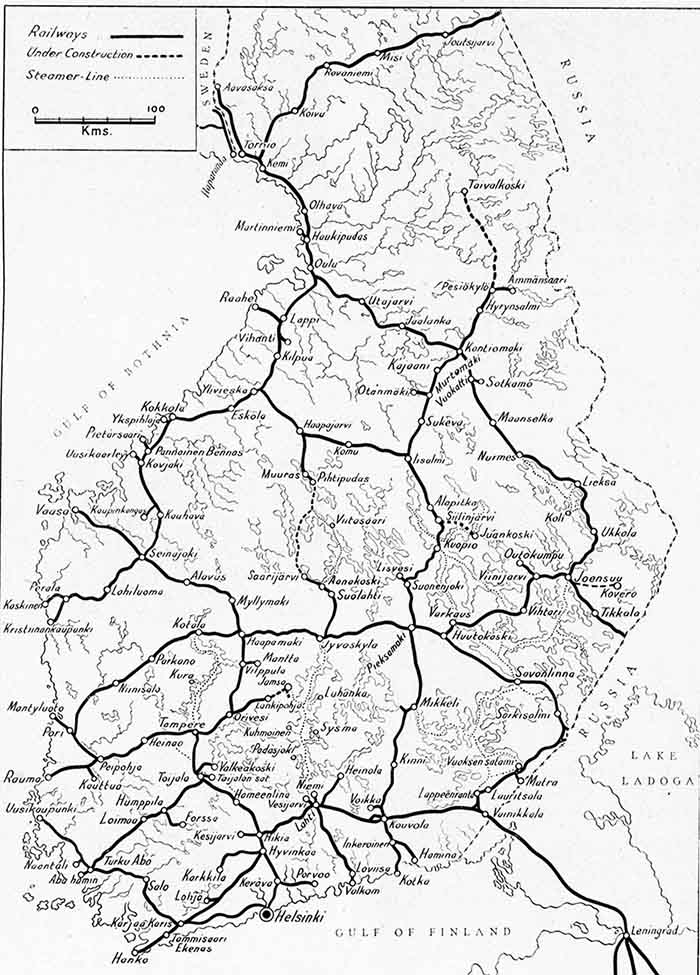The state railways of Finland are known as the Valtionrautatier (V.R) with the administration headquarters being situated in Helsinki.
A busy 1960's postcard scene of the trams and road traffic in Helsinki is shown below.
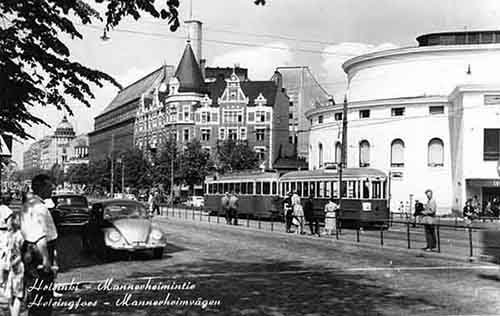
The first railway to be built in Finland ran between Helsinki and Hameelinna, opening in 1862 and was appoximately 100Km in length. The track gauge chosen for the main line was 5 feet which eventually enabled train services to run between Russia and Finland with the construction of the line from Helsinki to St Petersburg.
Commencing a journey from Helsinki to St Petersburg the line heads North westwards to reach the junction at Riihimaki on the line to Hameelinna. Turning Eastwards at the junction the line eventually skirts the shores of lake Paijanne and reaches the town of Lahti. The line then continues Eastwards crossing the Kymmen river, before reaching the town of Kouvola. Here the junction at Kuuvola heads Northwards for the interior of Finland and Southwards for the costal towns of Kotka and previously Hamina. The towns of Luumaki and Simola are encountered after which the wide river Viipuri is crossed followed by arrival at Vyborg station. From there in a South Easterly direction the city of St Petersburg is reached.
The railways of Finland have been celebrated on several postage stamps over the years as illustrated below.
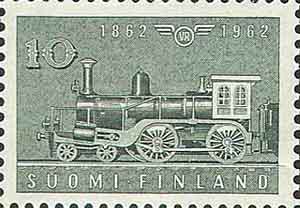
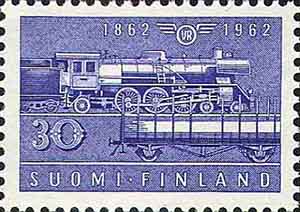
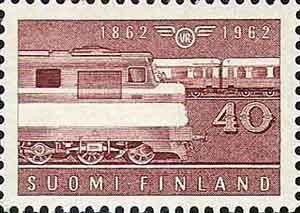
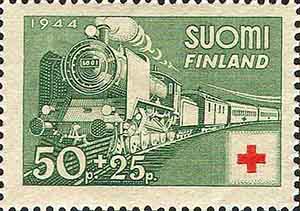
A further international rail connection exists in the far North of Finland with Sweden, at Tornio. This connection does however involve a change of rail gauge from the Russian 5 foot to the standard European gauge of 1435 mm. There is a stretch of dual gauge track between Tornio and Haparanda Sweden, that enables trains to overcome the gauge problem.
Heading southwards from Tornio towards Oulu, the railway skirts the coast of the Gulf of Bothnia (The northern arm of the Baltic sea) for over 80 miles. The line then splits with a line to Yliveska in the South West and to Kontiomaki in the South East, passing through the Finnish lake district. Travelling further South Westwards the industrial town of Tampere, an important railway junction, is reached. Tampere was once the location of a workshop used for the construction of many Finnish steam locomotives.
Several sea bourne international connections can also be made via the railways of Finland connecting with the many ports and ferry services. These services include ferry services from Turku to Stockholm, plus Hanko and Helsinki with services to many of the main Baltic ports.
A view of the costal town of Turku in the 1960's from a postcard with trams once again in evidence as a form of transport a shown below.
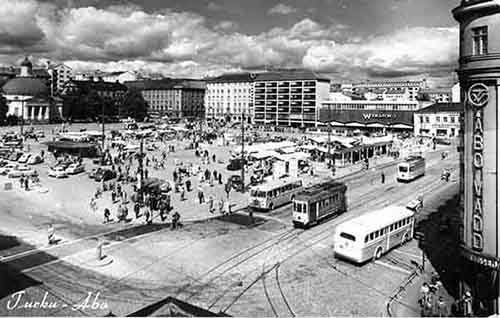
In addition to the standard 5 foot gauge rail network there were several private lines built to a narrow gauge, and the line from Hyvinkaa to Karkkila was no exception. This line ran for a distance of approximately 46 Km and had a gauge of 750mm, operating for a period of 56 years between 1911 and eventual closure in 1967.
In 1960 the Finnish state railways had 714 steam locomotives on its books as well as 46 diesel locomotives, being supplemented by 123 diesel railcars all of 5 foot gauge. In addition there were 13 narrow gauge locomotives of 750mm gauge operated by other private concerns.
As with most countries, at the very beginning of railway development in Finland during the 19th century, there was no indiginous source of locomotive manufacture. For this reason the initial locomotives were procured from a variety of overseas manufacturers including Neilson & Co, Dubs & Co, Avonside from Britain plus Baldwins of America, SLM of Switzerland and Sigl of Austria. Locomotive construction in Finland did however commence by the state railways in 1888. The majority of steam locomotives manufactured during the 20th century in Finland use the abundant supply of timber as a fuel source.
The main steam locomotive classification adopted in Finland uses letters to identify the locomotive. The H class is a passenger tender locomotive typically a 4-6-0 wheel arrangement. The T class is a freight tender locomotive typically a 2-8-0 wheel arrangement. The S class is a mixed traffic tender locomotive typically a 2-6-0 wheel arrangement. The P class is a passenger tank locomotive typically a 2-8-2 wheel arrangement. The V class is a freight or shunting tank locomotive typically a 0-6-0 wheel arrangement. This main classification letter is followed by a lowercase letter being k for under 11 tonnes, v for 11 to 14 tonnes and r for over 14 tonnes in weight. This is followed by a number indicating the age of the locomotive with 1 being the oldest of that type.
To view any full size image and caption details please click the maroon button below each thumbnail

